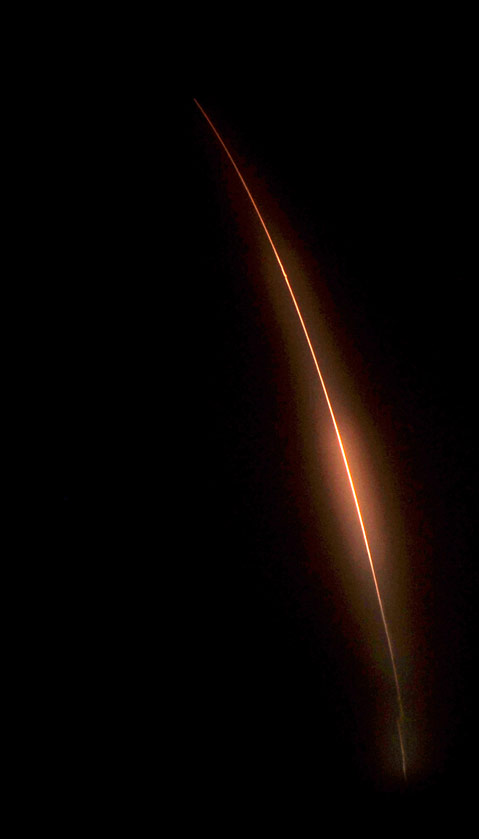Anatomy of a Nuke Missile Test
Vandenberg Launches ICBM in Show of Force
A Minuteman III — a nuclear-capable, intercontinental ballistic missile measuring 60 feet tall and 80,000 pounds — launches at the command of two key-turns in an underground missile alert capsule. At the facility, the missile is covered by a pentagonal platform that reportedly weighs about the same as a Boeing airliner and that lifts up onto its rails when command control gives the signal. Departure permitted, the missile punches out, and all that’s left behind is a smoking hole.
This week’s launch was the third and last of Vandenberg’s operational flight tests for this fiscal year. In the first two, which took place June 16 and June 30, the Minuteman III traveled 4,200 miles to a target near the Marshall Islands. This time its destination was 5,300 miles away, 200 nautical miles southwest of Guam. It takes the missile the exact same time to travel to both destinations, approximately 31 minutes, said Test Operations Flight Commander Christopher Terry as he gave The Independent a tour of the operations control room three hours before launch.

What is often missing in the coverage of missile test launches is the intricate and painstaking process a test launch requires: the six months of vigorous training and logistics, the technical processing of missile parts — the adding on of tracking, telemetry, and command-destruct systems — and the prestige of participating.
In this case, the Air Force Global Strike Command (the part of the military in charge of the nuclear arsenal) selected the missile from Minot Air Force Base in North Dakota and over a period of a few months, shipped its parts to Vandenberg. It also sent a task force to Vandenberg: 22 maintainers and operations personnel, including six combat mission-ready missileers. “Everyone who comes out here is highly motivated for this position. I’m not sure if you know this, but the 576 is the only dedicated ICBM test squadron in the Air Force,” said Lieutenant Colonel Trevor Hazen, the operations manager of the 576th Flight Test Squadron. “It’s an honor to come here.”
Any ICBM launch ignites controversy. “Why do you think they chose Guam?” asked Dennis Apel over the phone, a political activist from Guadalupe notoriously remembered for throwing his blood onto the Vandenberg sign. Maybe to gather data from other reentry angles? “Or maybe to show the world that we have a range that would cover anything from North Korea to China, an indication of what we’re able to do,” he replied, adding, “Even if that’s not the intent — because it’s hard to know the actual intent — it certainly has that effect.”
In the operations control room, accuracy, reliability, and — above all — safety are buzzwords constantly stressed when talking about the purview of these test flights, but the Vandenberg press release seems to confirm Apel’s speculation that missile test launches may be somewhat about credibility and the baring of teeth: “Strategic deterrence and assurance of our allies depends on potential adversaries being convinced of our nation’s capability to employ ICBMs if national interests are threatened,” said Colonel Bliesner, Commander of the 576th Flight Test Squadron, in a prepared statement.
For the test launch, the nuclear components are modified to be inert; what is called a “joint test assembly” mimics a complete nuclear warhead’s weight and configuration. Apel commented that the dummy warhead is still radioactive even though the nuclear components are modified to be inert. “The people in Kwajalein near the Marshall Islands, where we’ve been testing for years and years, can’t eat their fish anymore,” he said.
As a political theory, Mutually Assured Destruction (MAD) is a paradox, the Cold War logic of “we’re scared of nuclear missiles, so let’s build more.” And it’s a contributing reason for why David Krieger, president of the Nuclear Age Peace Foundation, along with other protesters, censures the hypocrisy of asking other countries to scale back their nuclear arsenal while actively testing our own.
The Obama administration has publicly stated an intention to figure out a way to make the twin forces of nuclear nonproliferation and deterrence coexist. The question, it says, is not whether or not the United States wants to scale down the arsenal of nuclear weapons; it’s how.
In the meantime, the Air Force Global Strike Command continues to schedule three flight tests a year and Vandenberg Air Force Base commences their cleanup stage, refurbishing the launch site and preparing for the next.



